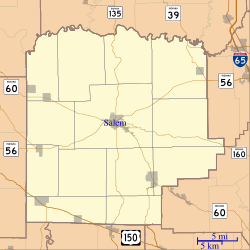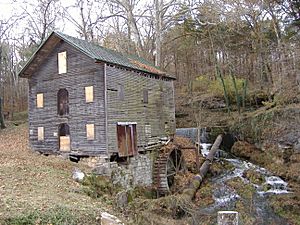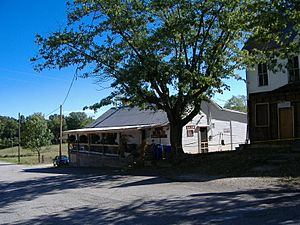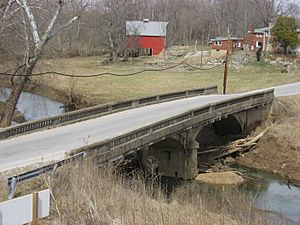Beck's Mill facts for kids
Quick facts for kids |
|
|
Beck's Mill
|
|
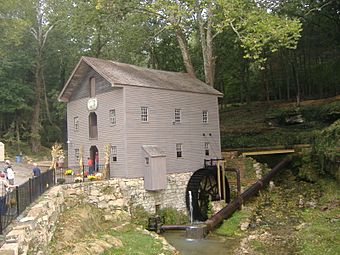
Beck's Mill, after restoration
|
|
| Location | Becks Mill, Indiana |
|---|---|
| Area | 14 acres (57,000 m2) |
| MPS | Grain Mills in Indiana MPS |
| NRHP reference No. | 90001789 |
| Added to NRHP | December 7, 1990 |
Beck's Mill is a very old gristmill located in Washington County, Indiana, in the United States. It's about 7 miles (11 km) southwest of Salem. The first mill was built in 1808. It was rebuilt in 1864 after a fire. This happened one year after John Hunt Morgan asked for money to save mills in Washington County from being burned. Beck's Mill was added to the National Register of Historic Places in 1990. It was once on a list of Indiana's most endangered historic places, but it received money for its restoration.
Contents
Where is Beck's Mill Located?
The mill sits in a rocky valley. It is surrounded by tall sycamore and maple trees. This area is one of the highest spots in Indiana. It is about 946 feet (288 meters) above sea level.
The Mill's Long History
The land where the mill stands was once an Indian burial ground. The Shawnee and Delaware tribes lived nearby. In 1807, George Beck came to Indiana Territory from North Carolina. He found a waterfall coming from a cave while hunting. He thought it would be a perfect spot for a mill. This waterfall is actually a large spring, the second largest in Indiana. The cave is about a mile long and provides water all year.
Building the First Mills
The first mill was built in 1808. It was a small stone and log building, about 11 feet by 11 feet. Beck built a small dam uphill from the mill. Water flowed from the dam through wooden troughs. This water turned the mill wheel. Some of the grinding stones came from France.
A second, larger mill was built in 1825. It was made of wood and replaced the first one. In 1828, two machines for carding (preparing wool) were added.
The Mill's Busiest Years
The current mill is the third one on the property. It was the first to have two stories. It also made furniture. From 1864 to 1890, the mill was very busy. It ran 24 hours a day. It used a turbine and waterwheel to turn the grindstones. Families sometimes waited three days for their corn to be ground. This led to a small settlement growing near the mill.
Later, modern roller mills became more common. They could grind grain much faster. Also, it became harder to transport goods to rural mills. Because of this, Beck's Mill stopped working in 1914. In 1963, a tornado hit the property.
Beck's Mill is the only one of 65 mills in Washington County that is still standing. Fewer than 20 mills remain in all of Indiana. The mill was put on Indiana's "10 Most Endangered List" because of water damage and people trespassing. Some people even damaged the mill. The Beck family owned the mill until November 2005.
Saving Beck's Mill: Restoration Efforts
A group called Friends of Beck's Mill is a nonprofit organization. Donald and Joyce Andersen gave them the 14-acre property and the mill building. Joyce is a direct descendant of the original George Beck family. This gift was made possible by D. Jack Mahuron. He hoped the mill could be saved and even start working again. He wanted it to be the main part of a local park.
In June 2006, a member of the Friends group won $1,000. They used this money to start a special fund for the mill. This fund helps market and operate the mill permanently.
Funding the Restoration
John Hawkins, an architect, estimated that $600,000 would be needed to restore the mill. More money would be needed to reopen it. Donald and Joyce Andersen also offered about 70 acres of land for trails and recreation. This land was later bought by Gayle Cook in 2012 and given to the Friends group. Three acres across the road are used for parking.
William and Gayle Cook are billionaires who help many good causes. They made a large donation of about $1,200,000 in 2007. This money helped start the restoration. Jack Mahuron knew the Cooks were interested in Beck's Mill. On March 1, 2007, the Cooks offered to fund the restoration. The Friends group happily accepted.
The Restoration Work
The restoration of the mill began in May 2007. The first step was to remove old equipment and tools. They also removed parts of the old general store and fabric-making machines. The old turbines were cleaned. The stone foundation was repaired by carefully lifting the mill. Outside work stopped for the year in September 2007. The mill's working parts were put back in place in spring 2008.
The Washington County Chamber of Commerce gave their "Citizen of the Year" award to the Friends group in 2007. This was for their work on the mill's restoration. Beck's Mill reopened to the public on September 20, 2008. This was just in time for the 200th anniversary of the first Beck's Mill.
After the restoration, Jack Mahuron asked the Hoosier Hikers Council to build walking trails. Over three years, hikers built more than three miles of trails. These trails allow the public to enjoy the spring, bluffs, quarry, and natural beauty of the park.
A 200-year-old log cabin on the hill behind the mill was also restored. This cabin was finished in the fall of 2011.
The Beck's Mill Settlement
After the Pigeon Roost Massacre in 1812, the Beck family built two small forts. These forts protected them from Native American attacks. The new protection helped draw more people to the area. In 1814, the settlement of Beck's Mill was considered to be the county seat of Washington County. However, Salem eventually became the county seat.
Today, the settlement is a crossroads. It is where Beck's Mill Road meets the Old Vincennes trail. There is a former fire station and a country store. The old Stage Coach stop from New Albany, Indiana, is also still standing. The Beck's Mill store has reopened. It is run as an old general store and museum. It also serves food like soups, sandwiches, and soft ice cream. An extremely old house next to the store is also being restored.
Beck's Mill Bridge
On September 20, 2007, the bridge near the mill was also added to the National Register of Historic Places. It is called the Beck's Mill Bridge or Washington County Bridge #105. It is a concrete arch bridge. It was designed by Daniel Luten, a famous engineer from Indiana. The bridge was restored in 2017.
Images for kids
See also


